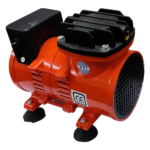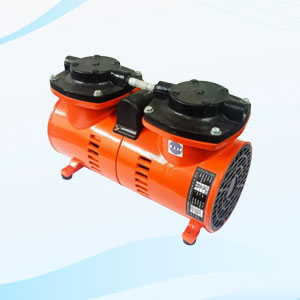Salient Features:
- No lubricant required
- Noiseless performance
- Absolutely portable
- Maintenance free
- All parts made from special graded Aluminum die-cast material for light weight and good strength
- Diaphragms are made of special 2-ply nylon reinforced neoprene rubber.
- Valves made of SS 316 material
- Built-in micro-suction filter
- Extra large bearings for trouble-free and smooth running.
- Pumps available with single as well as 3-phase motors
- Pumps available with SS 316 contact parts
- Pumps available in 110V AC motors
- Ideally suited for original equipment manufacturers
Application for use as Vacuum Pump:
- Laboratories
- Pollution control equipments
- Material handling equipments
- Labeling machines
- Disordering station
- Glass forming
- Medical instruments Dentists
- Chemical analysers
- Gas charging in A/c
- Suction machines
- Photographic developing machines
Application for use as Compressor:
- Flame Photometer
- Atomic absorption spectrophotometer
- Agitation of chemicals in electro-plating
- Agitation of film in drying tank
- Wave soldering machines for foaming of flux
- Cement aeration
- Oil-free spray painting
- Artist air brush
- Operating small pneumatic tools
- Laminating press
- Nebuliser
- Plastic Welding
A diaphragm vacuum pump is a type of positive displacement pump used to create a vacuum within a closed system. It operates by utilizing the movement of a flexible diaphragm, typically made of rubber or elastomer, to create changes in pressure within the pump chamber.
Here's how a diaphragm vacuum pump generally works:
Diaphragm Movement : The pump contains one or more flexible diaphragms that move back and forth within the pump chamber.
Pressure Variation : As the diaphragm moves, it alternately increases and decreases the volume of the chamber. When the volume increases, the pressure within the chamber decreases, creating a vacuum. Conversely, when the volume decreases, the pressure increases, expelling any trapped gases.
Valves : Diaphragm pumps usually include one-way valves to ensure the flow of gas occurs in one direction only, preventing backflow.
Applications : Diaphragm vacuum pumps are commonly used in laboratories, medical facilities, and various industrial processes where a clean, oil-free vacuum is required. They are suitable for applications such as filtration, degassing, and vacuum drying.
Oil-Free Operation : Unlike rotary vane pumps and other types of vacuum pumps that require lubricating oil, diaphragm vacuum pumps operate without oil. This makes them particularly suitable for applications where contamination by oil vapor is undesirable, such as in sensitive laboratory equipment or medical devices.
Maintenance : Diaphragm vacuum pumps generally require minimal maintenance compared to oil-sealed pumps. However, diaphragms may wear out over time and need replacement. Regular inspection and cleaning are recommended to ensure optimal performance.
Size and Capacity : Diaphragm vacuum pumps come in various sizes and capacities to suit different applications. Smaller, portable models are available for benchtop use in laboratories, while larger units may be used in industrial settings.
Overall, diaphragm vacuum pumps offer a reliable and efficient method for generating vacuum in a wide range of applications, particularly where oil-free operation and low maintenance are important considerations.
Services Area
- Ahmedabad |
- Ankleshwar |
- Baroda |
- Dudhrej |
- Gujarat |
- Rajkot |
- Surat |
- Bengaluru |
- Chennai |
- Delhi |
- Faridabad |
- Hyderabad |
- Kolkata |
- Maharashtra |
- Bangalore |
- Mumbai |
- Nashik |
- Navi Mumbai |
- Pune |
- Thane |
- Ulhasnagar |


